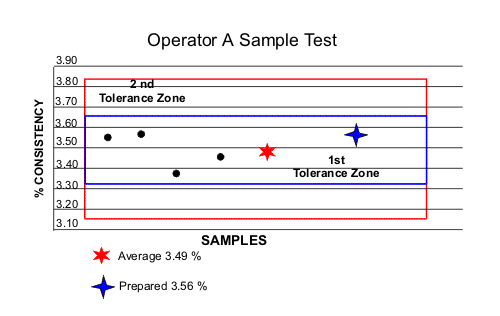
The Consistency Experts
-
 Consistency Experts for the Pulp & Paper industry!
>> more info
Consistency Experts for the Pulp & Paper industry!
>> more info
-
 Tighter consistency - and made right here in the USA. >> more info
Tighter consistency - and made right here in the USA. >> more info
Tech Tips - Proper Application of Hand Sample Results
Sampling Results : What do they mean?
Now that we have taken our sample and have the results, lets discuss the reliability of our numbers. Our experience has been that just about every paper mill we visit has some conflict with the sampling results and the output of the consistency meters. To help resolve this conflict the American Paper Institute did a study of hand sampling methods. They evaluated four different sampling devices on a recirculating flow loop designed for evaluating inline consistency sensors.
These consisted of:
- Sample valve drawing from center of stream
- Sample valve drawing from edge of stream
- Short section that could be closed off quickly to isolate a portion of the whole stream
- Open tank dipping of a well mixed slurry Five different pulp types from 0.27-3.56 % were examined.
System incorporated an agitated 2500-gallon tank, variable speed pump and 6" pipeline. A known amount of water and fiber was circulated in the system. Three operators pulled samples under the supervision of the principle investigator.
Flow rates were from 1 to 11 ft / sec., up to six samples were taken from each sampler for each run. Three different operators were involved.
The overall results were:
- The edge flow sampler gave somewhat lower consistencies, with the other samplers providing similar results.
- Uncertainty is dependent on the person doing the sampling.
- A few of the test showed large random errors.
- Repeatability averaging from 2-5% TAPPI Standard T 240 assigns a repeatability of 10%.
All three operators were within this requirement. However, Operator A was 2 ½ times better than Operator B, here are their numbers.
| Repeatability, % | Minimum | Maximum | Average |
| Operator A | 0.53 | 6.28 | 2.00 |
| Operator B | 0.79 | 28.99 | 4.55 |
| Operator C | 0.43 | 10.66 | 2.23 |
Sample results for operator A on southern pine are as follows;
| Known Consistency | Sample | Measured Consistency | Error, % | TAPPI Standard |
| 1 | 2.034 | -2.82 | +/- 5% | |
| 2 | 2.037 | -2.68 | ||
| 2.093 | 3 | 2.017 | -3.63 | 2.13 -1.93 |
| Average | 2.033 | -2.87 | ||
| 95% Level | 2.013-2.048 | |||
| 1 | 2.256 | +1.21 | +/- 5% | |
| 2 | 2.170 | +1.21 | ||
| 2.229 | 3 | 2.214 | -0.67 | |
| 4 | 2.216 | -0.58 | 2.45 - 2.10 | |
| Average | 2.214 | -0.67 | ||
| 95% Level | 2.145-2.283 | |||
| 1 | 3.551 | -0.34 | +/- 5% | |
| 2 | 3.565 | +0.06 | ||
| 3.563 | 3 | 3.385 | -5.00 | |
| 4 | 3.457 | -2.98 | 3.66 - 3.31 | |
| Average | 3.490 | -2.06 | ||
| 95% Level | 3.324-3.655 | |||
Note the results of test on 3.563 % consistency. Our average was 3.490; statistically we were with in the 95 % confidence range, however as you can see from this example we are still wrong. It is for this reason we recommend using the TAPPI standard and only change the consistency meter by half of the difference of sample and meter output.
If we take three consistency samples we will get three different answers. There is no way of knowing which answer is the "True Value". We average the three and use this average as the "Best" number.
Sample 1 = 3.02
Sample 2 = 3.00
Sample 3 = 3.10
Average = 3.04
Range = 0.10%
Common practice says that the Average is the true consistency is 3.04 %. Incorrect. We saw this happen to our operator. He was close but wrong It is close to 3.04 %. The Range tells you how close

If the Average does not indicate true consistency, what does it indicate?
"The Average value gives the midpoint of the ZONE where the true value is to be found."
TAPPI #T 240 is a test method that is used thru out the pulp and paper industry. It states a repeatability factor of 10 %. If we apply this to our Average sample results it can be shown on a chart as a TOLERANCE ZONE. TAPPI recommends a five-sample test; this TOLERANCE ZONE is much better for meter calibration. Lets plot out the results of operator A on bleached southern pine at 3.56% consistency.

By using the 10 % [+/- 5%] repeatability factor we are able to generate the 1st Tolerance Zone. Now we have an area were the meter and our sample should be considered as both being correct. No adjustment should be made to the consistency meter. TEMCO Engineering recommends a 2nd TOLERANCE ZONE. This is +/- 10 %. This zone indicates that the sample or the meter is suspect; another sample should be taken before any thing is done to the meter. Any sample that falls out side of this 2nd ZONE tells us that the meter needs adjustment. We recommend that only half of the difference between the sample and the meter be used as an adjustment factor for the transmitter. Then another series of samples should be pulled to verify that we moved in the right direction to correct meter calibration.
Our conclusion:
- Even when you pull multiple samples, using the proper sampling equipment, operator error then becomes the main factor for poor results.
- Statistical number crunching will not solve the problem; it can even hide the real reason. · Proper equipment and procedure will make the operator's job easier and will help reduce the chance of error. Even then we need to apply the TAPPI guidelines.
With this information you can now generate some suggested guidelines for proper consistency meter calibration and how much of an adjustment should be made when you sampling data and meter readings don't match.
Instrumentation Program Report No. 64, " On-Line Sampling Methods for Laboratory Consistency Measurement," Institute of Paper Science and Technology, Atlanta, GA.
